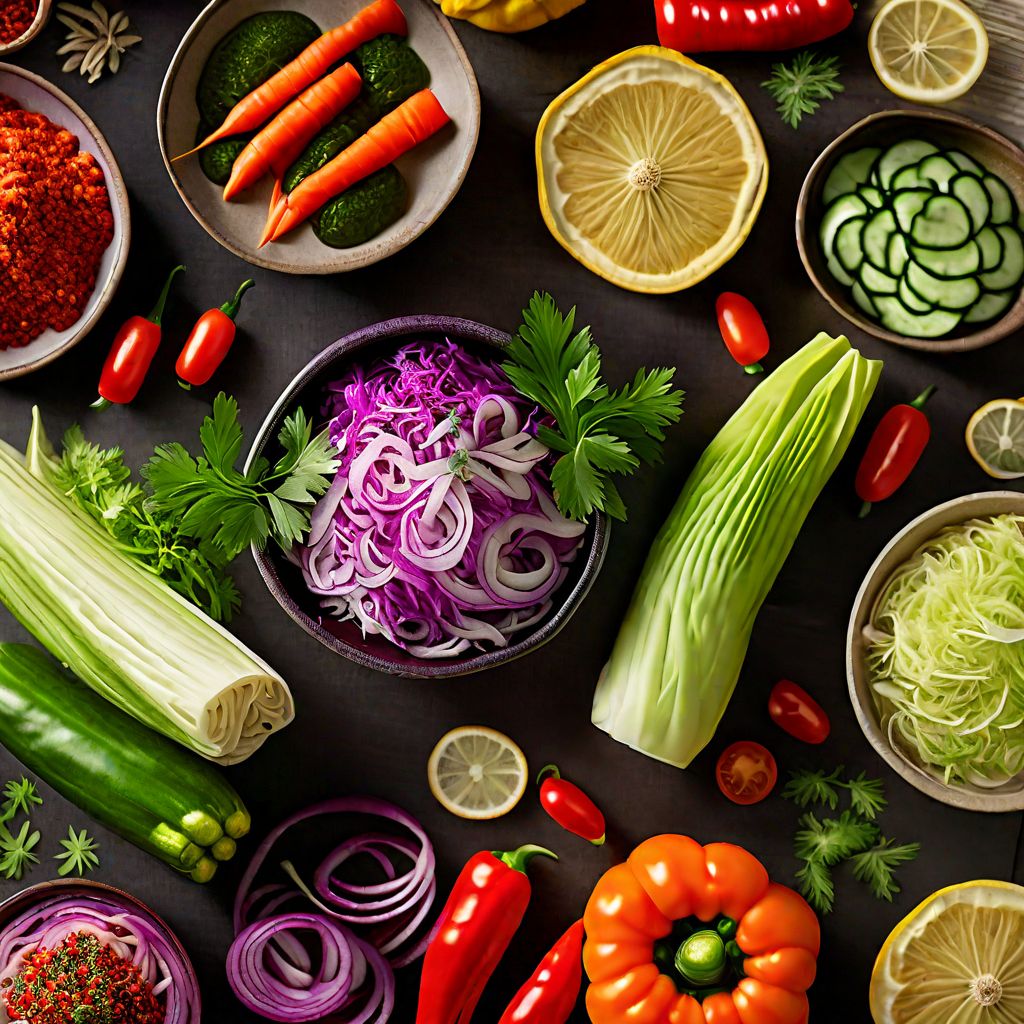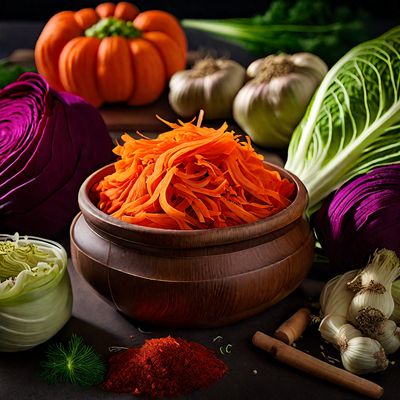
Recipe
Mediterranean-style Kimchi
Mediterranean Twist: Kimchi with a Mediterranean Flair
4.8 out of 5
In the vibrant world of Mediterranean cuisine, we bring you a unique twist on the traditional Korean dish, Kimchi. This Mediterranean-style Kimchi combines the bold flavors of the original recipe with the fresh and vibrant ingredients commonly found in Mediterranean cooking. Get ready to embark on a culinary journey that fuses the best of both worlds!
Metadata
Preparation time
20 minutes
Cooking time
0 minutes (fermentation time: 2-3 days)
Total time
2-3 days (including fermentation time)
Yields
4 servings
Preparation difficulty
Easy
Suitable for
Vegetarian, Vegan, Gluten-free, Dairy-free, Mediterranean diet
Allergens
N/A
Not suitable for
Paleo, Low-carb, Keto, Nut-free, Soy-free
Ingredients
While the original Korean Kimchi is known for its spicy and fermented cabbage, this Mediterranean adaptation incorporates a variety of Mediterranean vegetables and herbs. The traditional Korean chili flakes are replaced with aromatic herbs and spices, resulting in a milder yet equally flavorful version. The Mediterranean-style Kimchi also includes olives and sun-dried tomatoes, adding a delightful Mediterranean touch. We alse have the original recipe for Kimchi, so you can check it out.
-
1 head of Napa cabbage (500g / 1.1lb) 1 head of Napa cabbage (500g / 1.1lb)
-
2 tablespoons sea salt 2 tablespoons sea salt
-
1 red bell pepper, thinly sliced 1 red bell pepper, thinly sliced
-
1 cucumber, thinly sliced 1 cucumber, thinly sliced
-
1 carrot, julienned 1 carrot, julienned
-
1 small red onion, thinly sliced 1 small red onion, thinly sliced
-
4 cloves of garlic, minced 4 cloves of garlic, minced
-
1 tablespoon fresh ginger, grated 1 tablespoon fresh ginger, grated
-
1 tablespoon dried oregano 1 tablespoon dried oregano
-
1 tablespoon dried thyme 1 tablespoon dried thyme
-
1 tablespoon paprika 1 tablespoon paprika
-
1 tablespoon olive oil 1 tablespoon olive oil
-
1/4 cup pitted Kalamata olives, chopped 1/4 cup pitted Kalamata olives, chopped
-
1/4 cup sun-dried tomatoes, chopped 1/4 cup sun-dried tomatoes, chopped
-
2 tablespoons lemon juice 2 tablespoons lemon juice
-
1 tablespoon honey 1 tablespoon honey
Nutrition
- Calories: 120 kcal / 502 KJ
- Fat: 5g (Saturated Fat: 0.7g)
- Carbohydrates: 18g (Sugars: 9g)
- Protein: 3g
- Fiber: 5g
- Salt: 2g
Preparation
-
1.Cut the Napa cabbage into bite-sized pieces and place them in a large bowl. Sprinkle the sea salt over the cabbage and massage it gently. Let it sit for 1 hour to allow the cabbage to release its moisture.
-
2.Rinse the cabbage thoroughly under cold water to remove excess salt. Squeeze out any remaining water and transfer the cabbage to a clean bowl.
-
3.Add the red bell pepper, cucumber, carrot, red onion, garlic, ginger, dried oregano, dried thyme, paprika, olive oil, Kalamata olives, and sun-dried tomatoes to the bowl with the cabbage.
-
4.In a small bowl, whisk together the lemon juice and honey until well combined. Pour the mixture over the vegetables and toss everything together until evenly coated.
-
5.Transfer the Mediterranean-style Kimchi to a clean, airtight jar or container. Press down firmly to remove any air bubbles and ensure the vegetables are submerged in the liquid.
-
6.Seal the jar or container and let it ferment at room temperature for 2 to 3 days. After that, refrigerate the Kimchi to slow down the fermentation process.
-
7.Serve the Mediterranean-style Kimchi as a side dish or use it to add a burst of flavor to Mediterranean-inspired dishes.
Treat your ingredients with care...
- Napa cabbage — Make sure to massage the cabbage with salt thoroughly to ensure it becomes tender and releases its moisture.
- Kalamata olives — Use pitted Kalamata olives for convenience and chop them into small pieces for even distribution of flavor.
- Sun-dried tomatoes — If using sun-dried tomatoes packed in oil, drain them well before chopping.
Tips & Tricks
- For a spicier version, add a pinch of red pepper flakes or a dash of hot sauce.
- Allow the Kimchi to ferment for longer if you prefer a stronger tangy flavor.
- Use a clean utensil to remove the Kimchi from the jar to prevent contamination.
- Experiment with different Mediterranean herbs and spices to customize the flavor to your liking.
- Store the Kimchi in the refrigerator for up to 2 weeks to maintain its freshness.
Serving advice
Serve the Mediterranean-style Kimchi as a side dish alongside grilled fish or roasted vegetables. It also pairs well with Mediterranean-inspired salads and sandwiches. The tangy and flavorful Kimchi adds a refreshing element to any meal.
Presentation advice
Transfer the Mediterranean-style Kimchi to a beautiful serving dish and garnish it with fresh herbs such as parsley or basil. The vibrant colors of the vegetables will make the dish visually appealing. Serve it alongside other Mediterranean dishes to create a cohesive and enticing spread.
More recipes...
For Kimchi » Browse all
For Korean cuisine » Browse all
More Korean cuisine dishes » Browse all

Dwaeji galbi
Marinated Pork Ribs
Dwaeji galbi is a traditional Korean dish that consists of marinated pork ribs that are grilled or roasted. The dish is typically served with a...

Jeolpyeon
Jeolpyeon are a type of Korean rice cake made with rice flour and filled with sweet or savory ingredients. They are often served as a snack or appetizer.

Jangjorim
Soy-braised beef
Jangjorim is a traditional Korean dish that is made with beef and soy sauce. It is a popular side dish that is often served with rice or used as a...











